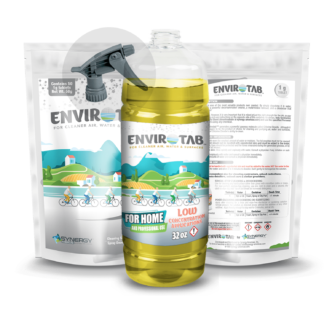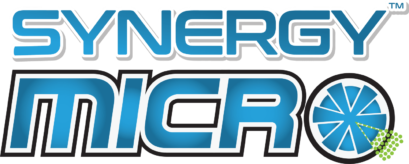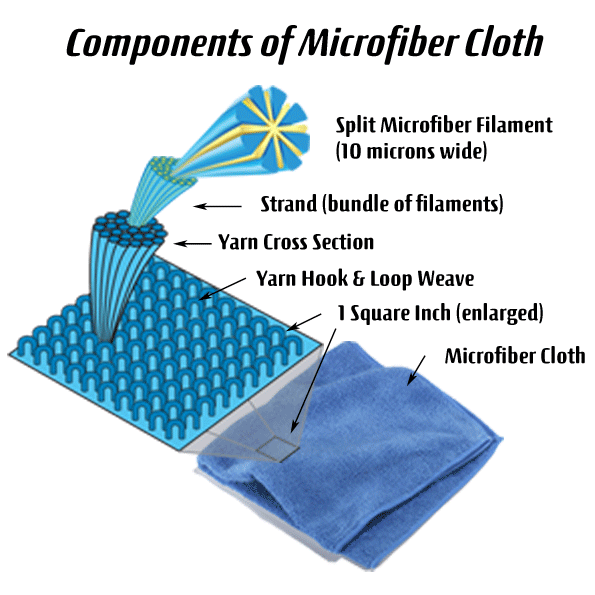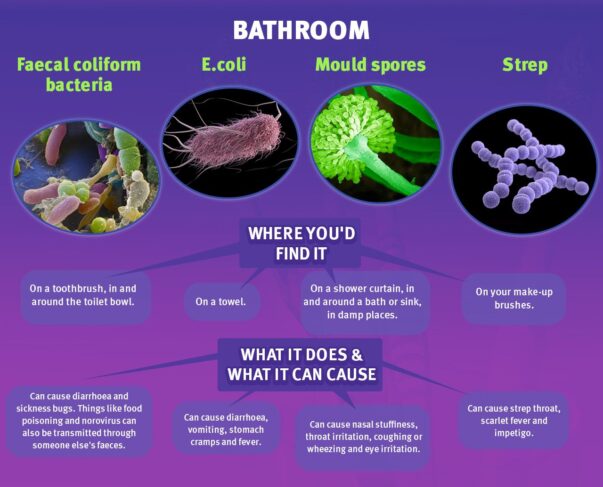Cleaning bathrooms with ClO2 & Microfiber
The surfaces found in bathrooms: porcelain, ceramic tile, chrome and stainless steel are all designed to be non-porous and generally germ-free. Cleaning with microfiber and a 100ppm solution (1g in 1 qt of water) will help to preserve that state.
Bathrooms - A Germs Favorite Breeding Ground...
Bathrooms are notorious breeding grounds for germs and bacteria. From the moment we enter, we are surrounded by potential sources of contamination. The most obvious culprit is the toilet, which can contain fecal matter and urine, both of which may harbor harmful microorganisms. Flushing the toilet releases a cloud of microscopic water droplets called aerosols, which can contain bacteria and viruses that become airborne and settle on surfaces within the bathroom.
Other germ-ridden areas within a bathroom include the sink, faucets, and soap dispensers. These surfaces are frequently touched by multiple individuals, transferring germs easily. Additionally, damp areas such as shower stalls and bath mats provide a perfect platform for the growth of mold, mildew, and fungi, which can cause various health issues including respiratory problems.
To minimize the spread of germs in bathrooms, regular cleaning and disinfecting is crucial. It is important to regularly sanitize surfaces such as toilets, sinks, and faucets, using appropriate cleaning agents that target bacteria and viruses. In public restrooms, frequent restocking of soap dispensers and toilet paper can ensure proper hygiene practices are followed. To further reduce the risk of contamination, individuals should adopt good personal hygiene habits like washing hands thoroughly with soap and hot water after using the bathroom, using hand sanitizer when necessary, and avoiding touching the face while in the bathroom. Additionally, regular ventilation of the bathroom can help remove moisture, reducing the growth of mold and mildew.
Chart at right produced by House Beautiful

Preparing a Bottle of 1g Envirotab!
A 32oz trigger bottle is the perfect item to keep around the house. This product makes an excellent cleaner, deodorizer and sanitizer for every hard surface of your home (except perhaps glass), and by breaking down proteins on contact, it enhances the performance of microfiber.
- Add 32oz of warm water to your Envirotab Secondary Trigger Sprayer bottle.
- To this water, add (1) 1g Envirotab Tablet, and secure the sprayer to the top of the bottle
- Let this sit for 1-2 minutes until the tablet is dissolved and the gas is equalized throughout the water.
- Follow the directions below, and keep this spray bottle out of the sun when not in use.


Microfiber - As Small as 1/100th the Diameter of a Human Hair and Able to Hold 8 TIMES its weight in Water & Soil
Microfiber cloths are made of incredibly fine synthetic fibers, typically measuring less than one denier in thickness. By comparison, a human hair is roughly 20 deniers thick. The fibers are extruded, creating a grooves that are able to gently scrape soil from hard surfaces and densely packed together, creating a large surface area that can pick up and trap dirt, dust, and other particles with ease.
When you clean with a microfiber cloth, the numerous tiny fibers scrape up and lock in dirt particles. These fibers also create a static charge - complementing the charge of Envirotab, which attracts and holds the dirt securely in place, preventing it from being redistributed on the surface you are cleaning. This unique ability to trap and hold onto dirt and dust is what makes microfiber cloths so effective at removing even the smallest particles from surfaces.
Furthermore, microfiber cloths are extremely absorbent, capable of holding up to eight times their weight in liquid. This allows them to easily wipe up spills and moisture from surfaces without leaving any residue behind. Whereas microfiber requires only 20% of the water and cleaning solution as other materials (like cotton), microfiber reduces the need for harsh chemicals that can potentially harm surfaces or the environment.
The fibers in microfiber cloths also generate a mechanical cleaning action as you rub them against a surface. This friction removes even stubborn stains and grime much more effectively than traditional cleaning cloths.
Overall, the unique construction of microfiber cloths makes them an incredibly effective cleaning tool when paired with chlorine dioxide tablets. They are able to capture microscopic particles - even bacteria, yeast, fungi and viruses, absorb significant amounts of liquid, and efficiently remove dirt and stains with minimal effort.
Shop Envirotab Tablets and Get the Best Value in Cleaning & Deodorizing Available
Who Needs Envirotab Tablets & What Size Fits Your Applications Best?
To put it simply EVERYONE needs the simplicity, efficiency, power and efficacy of our Simply the BEST Chlorine Dioxide Tablets Available Anywhere!
- Homeowners: Take a quick look at all of the applications below to see what you can do with just our 1 gram tablets and be AMAZED!.
- Contract Cleaners: Every contract cleaner should stock and use our 4 gram tablets for cleaning, odor remediation, toilet reclamation, mold & mildew .
- Hotel Housekeeping: Deep cleaning rooms after a long-term stay or pet stay will eliminate odors, freshen the air and reduce pet stress from past tenants.
- Auto Dealers & Detailers: Detailers use the 1 gram tablets for washing down the dash, doors, headliner and upholstery, then gas the car with 20g.
- Marinas & Campgrounds: Resell 1g tablets & 20g kits for deodorizing musty tents, campers and boats. Eliminate the odors and keep mildew from forming.
- Veterinary Clinics & Kennels: 1 gram tablets are perfect for cleaning exam rooms while 10 gram tablets make a great 3 gallon solution for kennels.
- Farmers & Homesteaders: The uses around the farm are endless! 1 gram tablets for udder wash before milking, removing black spots from plant follage and cleaning tools. 4 gram, 10 gram and 20 gram for treating water, cleaning greenhouses and sanitizing stalls after cleaning.



